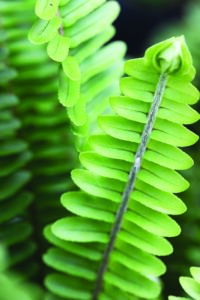
Some ferns, such as the Boston fern, grow so fast that they shade out the fronds underneath.
Ferns are usually found under the shady canopy of tall trees near streams and ponds, but many can be found in warm homes all year long.
Indoor ferns have delicate or sturdy green fronds that are made up of leaflets and a stem.
Some ferns have arching fronds that look graceful while others have sharp, upright spikes of fronds that give and indoor gardens energy.
Ferns will keep their bright green color all winter long and can be a wonderful companion to other indoor plants.
Grouping ferns with other house plants can enhance the colors and textures of both, and the grouping will also help raise the amount of moisture in the air that the ferns need.
All ferns need moisture in the air as well as in the soil.
Misting the ferns once a day is an excellent way to help keep the humidity up, and another way is to place the pots of ferns on a tray of pebbles and keep the tray filled with water once a week.
Ferns like soil moisture but can’t survive soaking wet soils, so be sure to allow the water from the ferns to drain in a saucer after watering for about 10 to 15 minutes then pour the remaining water out. All ferns like low light levels so they are perfect for the indoor gardener who only has north- or east-facing windows.
They also prefer day temperatures between 60 and 70 degrees and 10 degrees cooler during the night.
Ferns come in many shapes and sizes that fit well with indoor gardening.
The Rabbit Foot fern (Polypodium aureum) is a small fern which has delicately cut light green leaves and rhizomes that are thick and furry, looking just like a lucky rabbit’s foot.
Button ferns (Pellea rotundifolia) grow 12 to 18 inches tall and have small dark green round leaves that are thick and rubbery evenly placed on either side of the slender arching stems.
Boston fern (Nephrolepis exaltata) is a popular fern due to its ability to thrive in most homes indoors and there are a number of different cultivars ranging from “Bostoniensis” with it arching fronds up to 3 feet long and cascade over the pots to “Fluffy Duffy,” a very fringed and compact plant growing only 8 to 12 inches tall.
Boston ferns are the easiest to grow, needing low soil moisture while the Maidenhair fern (Adiantum tenerum) is the most difficult to grow, needing both high humidity and moist soil at all times.
The Maidenhair fern is very delicate with fan shaped leaflets on a slender black stem.
Ferns that need a lot of high humidity will do very well in a terrarium. Some ferns like the Boston fern grow so fast that they shade out the fronds underneath.
Trimming the dead fronds once a month can keep the ferns looking neat and clean.
Be aware that water softeners use salt to condition the water and can be too salty for watering ferns.
Clay pots are great for ferns as they have a tendency to create better air flow into the potting soils, preventing root rots.
(Editor’s Note: Ginny Rosenkranz is a commercial horticulture specialist with the University of Maryland Extension.)



